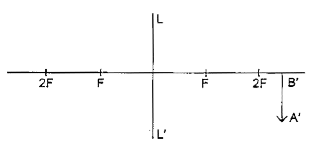An image of the sun is formed by a lens, of the focal length of 30 cm, on the metal surface of a photoelectric cell and a photoelectric current I is produced. The lens forming the image is then replaced by another of the same diameter but of focal length 15 cm. The photoelectric current in this case is
I2
I
2I
4I
The correct Answer is:B
To solve the problem, we need to analyze the effect of changing the focal length of the lens on the photoelectric current produced in the photoelectric cell.
1. Understanding the Setup:
- We have a photoelectric cell where sunlight is focused using a lens.
- The first lens has a focal length of 30 cm, and it produces a photoelectric current I.
2. Replacing the Lens:
- The first lens is replaced by another lens with the same diameter but a shorter focal length of 15 cm.
3. Intensity and Photoelectric Current:
- The intensity of light (which is related to the number of photons hitting the surface per unit area per second) is what determines the photoelectric current.
- The photoelectric current I is directly proportional to the intensity of light incident on the photoelectric cell.
4. Relation Between Focal Length and Intensity:
- The intensity of light at the photoelectric cell depends on how much light is focused onto the area of the cell.
- The intensity of light is also related to the area over which the light is spread. A lens with a shorter focal length focuses light more tightly, but this does not affect the total number of photons (or the intensity) that are produced by the sun.
5. Conclusion:
- Since the intensity of light and thus the number of photons hitting the photoelectric cell does not depend on the focal length of the lens, the photoelectric current produced remains the same.
- Therefore, the photoelectric current with the second lens is also I.
Final Answer:
The photoelectric current in the second case is I.
---
- We have a photoelectric cell where sunlight is focused using a lens.
- The first lens has a focal length of 30 cm, and it produces a photoelectric current I.
- The first lens is replaced by another lens with the same diameter but a shorter focal length of 15 cm.
- The intensity of light (which is related to the number of photons hitting the surface per unit area per second) is what determines the photoelectric current.
- The photoelectric current I is directly proportional to the intensity of light incident on the photoelectric cell.
- The intensity of light at the photoelectric cell depends on how much light is focused onto the area of the cell.
- The intensity of light is also related to the area over which the light is spread. A lens with a shorter focal length focuses light more tightly, but this does not affect the total number of photons (or the intensity) that are produced by the sun.
- Since the intensity of light and thus the number of photons hitting the photoelectric cell does not depend on the focal length of the lens, the photoelectric current produced remains the same.
- Therefore, the photoelectric current with the second lens is also I.
The photoelectric current in the second case is I.
Topper's Solved these Questions
- PHOTOELECTRIC EFFECTBook:CENGAGE PHYSICS ENGLISHChapter:PHOTOELECTRIC EFFECTExercise:Multiple Correct
Explore 10 Videos
- PHOTOELECTRIC EFFECTBook:CENGAGE PHYSICS ENGLISHChapter:PHOTOELECTRIC EFFECTExercise:Linked Comprehension
Explore 44 Videos
- PHOTOELECTRIC EFFECTBook:CENGAGE PHYSICS ENGLISHChapter:PHOTOELECTRIC EFFECTExercise:Subjective
Explore 16 Videos
- NUCLEAR PHYSICSBook:CENGAGE PHYSICS ENGLISHChapter:NUCLEAR PHYSICSExercise:ddp.5.5
Explore 14 Videos
- RAY OPTICSBook:CENGAGE PHYSICS ENGLISHChapter:RAY OPTICSExercise:DPP 1.6
Explore 12 Videos
Similar Questions
Knowledge Check
The diagram below shows an image formed at a distance 36 cm from the lens LL' of focal length 12 cm. With respect to this answer the questions that follow.

If the lens LL'. is replaced by another lens of same type but focal length 15 cm then for the same object distance.Athe size of the image decreases.Bthe size of the image increases.Cthe size of the image remains the same.Dinformation is insufficient to conclude.
If the focal length of the lens is 20 cm, find the distance of the image from the lens in the following figure?

View SolutionA concave lens has focal length of 15 cm. At what distance should an object from the lens be placed so that it forms an image at 10 cm from the lens ? Also, find the magnification of the lens.
View SolutionThe focal length of a converging lens is 8 cm. Fins the magnification power when it is used as a reading lens to form the image at near point.
View SolutionA convex lens has a focal length of 20 cm. It is used to form an image of an object placed 15 cm from lens. The image is
View Solution(i) A diverging lens of focal length 15 cm, forms an image at distance of 10 cm from the lens. How far is the object placed from the lens ?
(ii) What is the linear magnification of the image?
View SolutionDraw a labelled ray diagram for the formation of image by a convex lens of focal length 15 cm when the object is placed at a distance of 25 cm from the lens. Determine the size of the image formed, if size of the object is 4 cm.
View SolutionA converging lens of focal length 40 cm is kept in contact with a diverging lens of focal length 30 cm. Find the focal length of the combination.
View Solution